Hoka One One EVO Speedgoat
Test Location: Gunnison-Crested Butte Valley, CO
Test Duration: 270 miles
Stated Stack Height: 32 mm (heel) / 28 mm (forefoot)
Stated Heel-to-Toe Drop: 4 mm
Stated Features:
- Upper: MATRYX textile with high-tensile synthetic fiber strands across midfoot for unparalleled strength and durability at minimal weight
- Non-wicking treated fabric optimizes water drainage
- Gusseted tongue
- Midsole: CMEVA foam to absorb impact and offer stable footing
- Outsole: Vibram Megagrip high-traction outsole with 5 mm lugs
MSRP: $160
Size Tested: US Men’s 11.5
Stated Weight per Shoe (US Men’s Size 9): 281 g / 9.9 oz
Blister Measured Weight per Shoe (US Men’s Size 11.5): 311 g / 11.0 oz
Reviewer: 6’1”, 145 lbs
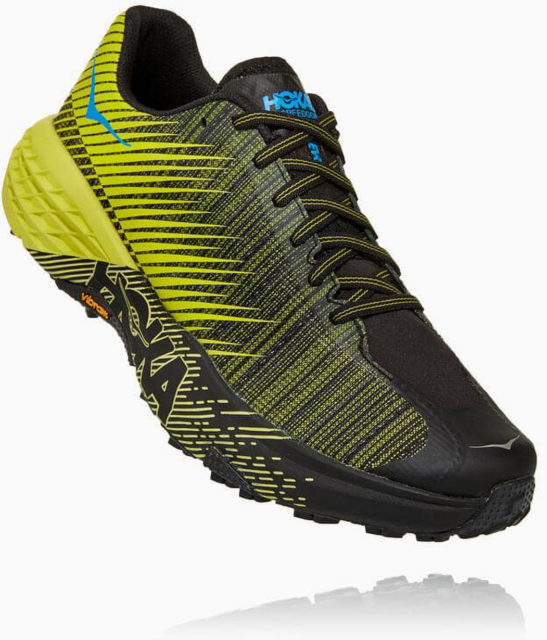
Intro
I generally prefer lighter shoes with more moderate stack heights, so most of Hoka One One’s maximal trail shoes hadn’t really caught my interest in the past. However, as I’ve continued to progress to longer trail races and runs, I’ve often wished for a more cushioned option that can provide a little more protection without weighing me down.
Enter the Hoka One One Evo Speedgoat. In Hoka’s words, the Evo Speedgoat “takes the Speedgoat 3’s max-cushion, max-traction base, and adds a racing-weight, super-strong upper.” Sounds like a lot of buzz words to me, but the Evo Speedgoat does reportedly weigh in about an ounce lighter than the Speedgoat 4. As someone who’s accustomed to more minimal shoes, I was curious to see what a max-cushioned, yet race-oriented shoe would feel like.
So how does the Evo Speedgoat compare to the lighter, lower to the ground shoes that I’m used to running in? And does it fulfill its intended purpose of “covering any terrain — fast?” After about 270 miles in the shoe, I’ll provide my thoughts about what the Evo Speedgoat does well, what I think could be improved, and how it stacks up relative to other shoes I’ve used.
Previous Versions
We’ve previously reviewed both the Speedgoat 2 and the Speedgoat 3, which share many of the Evo Speedgoat’s features. The Evo Speedgoat has the same midsole and outsole as the Speedgoat 3, but with a completely different upper. I’ll primarily focus on what makes the Evo Speedgoat different from other versions of the shoe in this review, but know that if you like the cushion and traction of the Speedgoat 3, the Evo version will feel very similar.
It’s also worth noting that Hoka recently released the Speedgoat 4, which has a wider forefoot, updated midsole foam, and additional midfoot overlays for extra support relative to the Speedgoat 3. The Evo Speedgoat has not received any of these updates for 2020, so its fit and cushioning should be more similar to the Speedgoat 3 than the 4.
Fit
We always recommend trying shoes on in person before you buy them, but our fit descriptions can at least act as a starting point. For reference, I have fairly narrow, low-volume feet with low arches. I generally like a shoe that fits snugly through the heel and midfoot but gives my toes a bit more space to spread out.
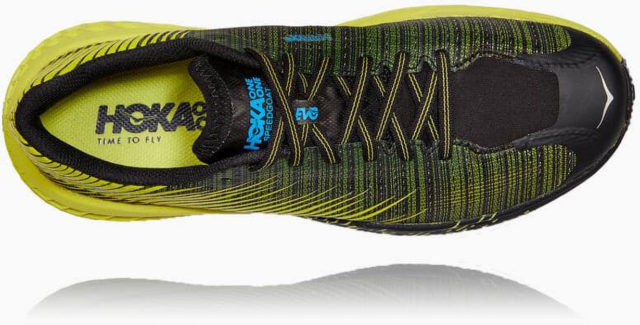
Like the Speedgoat 3, the Evo Speedgoat feels fairly narrow throughout. In the heel and midfoot, this translates to a secure, locked-down-feeling fit. Unfortunately, it also means that there’s not a whole lot of room in the Evo Speedgoat’s toe box. While I haven’t had any issues so far, my toes definitely feel a bit more squished together in the Evo Speedgoat than in shoes with more spacious toe boxes like the Nike Terra Kiger 5 or Altra Timp 1.5. With that said, I do appreciate the Evo Speedgoat’s secure fit for the most part, particularly because the Evo Speedgoat is higher off the ground than I’m used to. The tighter fit definitely improves the shoe’s performance on technical terrain, but it’s not as comfortable for me as the Timp 1.5 during longer runs.
I especially like the Evo Speedgoat’s gusseted tongue, which is one of the features that sets it apart from the Speedgoat 3. Like the Nike Terra Kiger 5, the tongue on the Evo Speedgoat is anchored to the midsole with a stretchy elastic gusset that holds the foot in place and keeps the tongue from sliding around during runs. While I haven’t personally run in the Speedgoat 3, I would imagine that the Evo Speedgoat’s gusseted tongue makes the fit through the midfoot somewhat tighter, so it may be a bit less comfortable for runners with wider feet.
The Evo Speedgoat also has a slightly higher arch than the Nike Terra Kiger or Altra Timp. This extra support is mostly a result of the shoe’s midsole shape. I probably only noticed it because my arches are fairly flat, as the Evo Speedgoat is still definitely not what I’d consider a pronation control shoe, but I think it adds to the secure-feeling fit in the midfoot.
Weight
Much like the Altra Timp 1.5, the Evo Speedgoat feels much lighter on the trail than it is on paper. I think this goes back to the energetic, smooth ride of the Evo Speedgoat (more on that later). With a stated weight of 9.9 oz / 281 g per shoe for a US Men’s size 9, it’s not an impressively light shoe, but it rarely felt heavy or cumbersome on trail. In especially technical terrain it doesn’t feel quite as light and nimble as a more minimal shoe like the Salomon Sense Pro 4, but aside from that, the Evo Speedgoat’s weight didn’t impact the shoe’s performance. It’s also worth noting that it’s as light or lighter than most other trail shoes with similar stack heights. For comparison, here’s how the stated weight of the Evo Speedgoat stacks up against other similar shoes (all weights based on a US Men’s 9):
264 g / 9.3 oz — Topo Athletic MTN Racer
275 g / 9.7 oz — Hoka One One Challenger ATR 5
281 g / 9.9 oz — Hoka One One Evo Speedgoat
281 g / 9.9 oz — Altra Timp 2.0
292 g / 10.3 oz — Hoka One One Speedgoat 3
298 g / 10.5 oz — Nike Wildhorse 6
306 g / 10.8 oz — Hoka One One Speedgoat 4
Upper
The Evo Speedgoat’s upper is unique, to say the least. Hoka uses a similar “MATRYX” upper material for their other race-oriented trail shoes, the Evo Mafate 2 and the Evo Jawz. When we reviewed the original version of the Evo Mafate, reviewer Jaden Anderson was pretty impressed by the MATRYX upper’s durability and low weight. For the most part, the same holds true for the Evo Speedgoat.
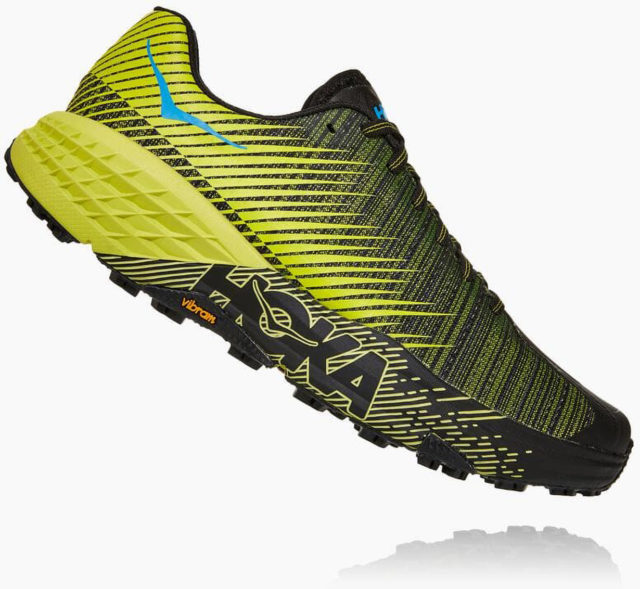
The MATRYX material used for the Evo Speedgoat’s upper is a Kevlar/polyamide mix that’s supposed to be much lighter and much more durable than the traditional mesh and synthetic overlays found on most shoes. So far, those claims appear to be true. The Evo Speedgoat’s upper feels extremely thin and minimal, but it’s also surprisingly durable and supportive. It doesn’t show any signs of wear after 270 miles of use, and it still holds the foot in place surprisingly well for how thin it feels.
The one downside I’ve found is that it’s not nearly as stretchy as the upper materials found on most shoes, which contributes to a slightly constricting fit in the forefoot. The neoprene-like material used for the top of the toebox helps with this a little, but the MATRYX material on the sides doesn’t really stretch to accommodate toe-splay
The Evo Speedgoat’s upper also has a non-wicking treatment (i.e., decreases water absorption), which does a great job of limiting how much water the shoe retains after stream crossings. Most shoes feel super wet and squishy for at least a mile or two after stream crossings, but the Evo Speedgoat drains pretty completely within a few steps. I am a little concerned that the tightly woven, non-wicking upper won’t breathe very well in hotter weather, but I haven’t had any issues in temperatures up to about 65º F / 18º C. I’ll be back with updates if I do run into breathability issues as the temperatures warm up.
Midsole
As somewhat of a maximal shoe neophyte, I was very impressed by the Evo Speedgoat’s midsole cushioning. I was worried that the shoe would feel bulky, slow, & inefficient relative to the lightweight, lower-stack shoes that I’m usually using. Instead, the Evo Speedgoat feels surprisingly springy and nimble while muting almost all ground-feel. The shoe doesn’t have a rock plate, but the thick midsole provides plenty of protection from sharp trail obstacles. The Evo Speedgoat’s ride is more cushioned than any other shoe I’ve run in recently, but it also feels like it’s got better energy return than most other shoes. The Altra Timp 1.5 has a similar stack height, but the Evo Speedgoat feels much more cushioned on trail. I can still feel sharp rocks or roots through the Timp 1.5’s midsole, but the Evo Speedgoat mutes pretty much all ground feel. Hoka’s CMEVA midsole foam also feels slightly more springy and energetic than the A-Bound material Altra uses on the Timp 1.5.
In combination with the shoe’s rockered shape, the springy midsole makes the Evo Speedgoat feel smooth and fast on up-tempo runs. While I haven’t had the chance to race in the Evo Speedgoat yet, it will definitely be a contender when I’m picking shoes for summer races (if they happen…).
Outsole
Like the Speedgoat 3, the Evo Speedgoat has a Vibram MegaGrip outsole with 5 mm directional lugs. Blister reviewer Maddie Hart was a fan of the Speedgoat 3’s outsole, and I think that it works equally well on the Evo Speedgoat.
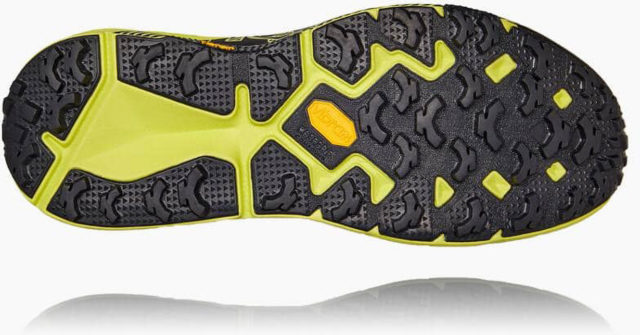
The 5 mm lugs provide ample traction on most trail surfaces, and work decently well in mud and snow as well. I have had some issues with mud building up in between the Evo Speedgoat’s lugs in muddy conditions. That’s not too surprising by itself, as pretty much every shoe I’ve run in — with the exception of mud-specific models like the Inov-8 X-Talon 212 or Hoka Evo Jawz — has the same problem, but the Evo Speedgoat’s outsole seems to pick up and retain more mud than most shoes. While this isn’t a serious issue for most runs, it is annoying enough that I wouldn’t recommend the Evo Speedgoat for runs where you anticipate lots of sticky mud.
Aside from that, the Evo Speedgoat’s outsole works quite well. The MegaGrip rubber grips well on wet rocks without being overly sticky on smoother, drier terrain. I was a little worried that the stickier rubber compound would mean premature wear-down, but the Evo Speedgoat’s outsole shows fairly minor signs of wear after 270 miles in the shoe.
On Trail
I’ve worn the Evo Speedgoat on a mix of non-technical / flat trails, steep / rocky trails, and even some roads. I’ve also tested them on snow, ice, and mud. Overall, I’ve been very impressed. The Evo Speedgoat feels at home on both technical and non-technical terrain. On non-technical trails, the springy midsole and rockered profile make the Evo Speedgoat feel smooth and efficient in spite of its size. On technical, off-camber terrain, the locked-down fit and excellent grip make the shoe way more stable than I would have expected.
With that said, the high stack height does still make the Evo Speedgoat a bit less stable than a lower-stack shoe like the Nike Terra Kiger 5 or La Sportiva Bushido II on especially steep, loose terrain. I didn’t notice the “topple-over” feeling that reviewer Maddie Hart experienced in the Speedgoat 3 on technical terrain, but the Evo Speedgoat’s higher stack height isn’t nearly as confidence-inspiring as the low to the ground designs of the Terra Kiger 5 or Bushido II. At the same time, that extra cushion also pretty much eliminates the foot fatigue issues that I’ve had in the Terra Kiger 5 on longer runs. As a result, the Evo Speedgoat has become my go-to shoe for longer runs that don’t include lots of technical terrain.
As previously mentioned, the Evo Speedgoat grips well on everything except deep mud and snow / ice. The MegaGrip outsole rubber and fairly aggressive lugs provide much more grip than the Altra Timp 1.5 or Nike Terra Kiger 5.
The overall feel of the Evo Speedgoat reminds me the most of the Altra Timp 1.5. The Timp definitely has a slightly more comfortable fit for my preferences (due to its wider toe box), but the Evo Speedgoat feels much more springy and energetic. The Evo Speedgoat also limits ground feel much more than the Timp 1.5, which is a positive for maximal-shoe fans. Neither shoe is especially confidence inspiring on technical terrain, but the Evo Speedgoat does feel a bit more unstable than the Timp on rocky, off-camber trails because of its narrower platform.
Durability
Durability might be the Evo Speedgoat’s most impressive feature, at least in my experience. The upper still looks exactly the same as it did when the shoes were brand new, and the outsole has just started to show some slight signs of wear after 270 miles. I ran quite a few road miles in the Evo Speedgoat last winter, so I expected the outsole to wear down much faster than it has. In addition, the midsole cushioning doesn’t seem to have lost any of its spring after 270 miles of use. I expect these shoes to keep going for at least another 200 miles. I’ll post a longer-term durability update if I run into any issues down the road.
Update: After 410 miles in the Evo Speedgoat, I continue to be very impressed with its durability. I’m totally sold on the MATRYX upper at this point — it still looks pretty much flawless, which is amazing considering how much abuse I’ve put it through. The Vibram MegaGrip outsole is equally bomb-proof. A few lugs in high-wear areas, like the very front of the toe and outside of the forefoot, have just about worn off, but the rest of the outsole is holding up very well. It probably doesn’t provide quite as much traction as it did when the shoes were new, but I haven’t noticed a significant decrease in the Evo Speedgoat’s grip so far. Finally, the midsole is still surprisingly springy and energetic. I’m sure that it has compacted a bit over the last 400 miles, but so far that change has been small enough that it hasn’t impacted the shoe’s ride.
I’d be happy to get 410 miles out of any shoe, and the fact that the Evo Speedgoat is a stripped back, lightweight racing shoe makes its excellent durability even more impressive. It also makes it much easier to stomach the shoe’s fairly steep $160 price tag. I’ll be curious to see how much longer the Evo Speedgoat keeps on going — and what ultimately prompts me to retire them. So far there’s no end in sight.
Who’s It For?
The Evo Speedgoat is marketed as a racing shoe, and I’m certainly considering using it for races in the future. But it also works very well as an everyday training shoe, particularly for long runs on moderate terrain. The narrower fit might cause some issues for runners with wide feet, and the high stack height does make for a less stable ride on technical terrain.
But in my opinion, the Evo Speedgoat strikes a really nice balance between weight, cushion, and protection for most uses. If you’re a fan of maximal shoes and you’re looking for a lighter option that’s still got plenty of cushion, the Evo Speedgoat should fit the bill as long as it fits your feet. And if, like me, you usually run in low-stack shoes and want an option with more cushioning that won’t make it feel like you’re running with a brick on your foot, the Evo Speedgoat is definitely worth checking out.
Bottom Line
I’ve enjoyed running in the Hoka One One Evo Speedgoat way more than I would’ve expected, given its maximal design and my personal shoe preferences. While the Evo Speedgoat’s lighter upper might seem like a fairly minor tweak to the Speedgoat 3, I think it makes the Evo Speedgoat a better option for a much wider range of runners. It has the cushioning to decrease foot fatigue on longer runs, but feels light and fast enough to be a solid option for shorter, faster days as well. When paired with its excellent durability, I think that the Evo Speedgoat’s versatility makes it an appealing option for a protective, well-cushioned, “do it all” trail shoe.

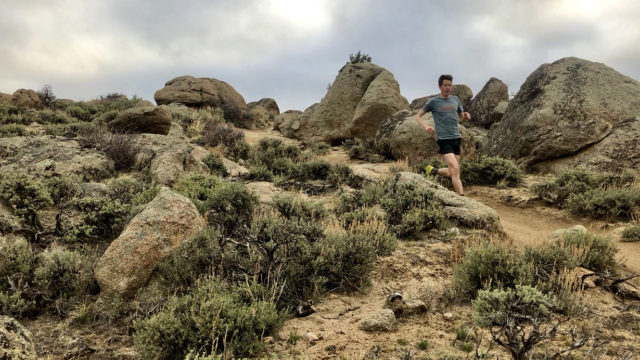
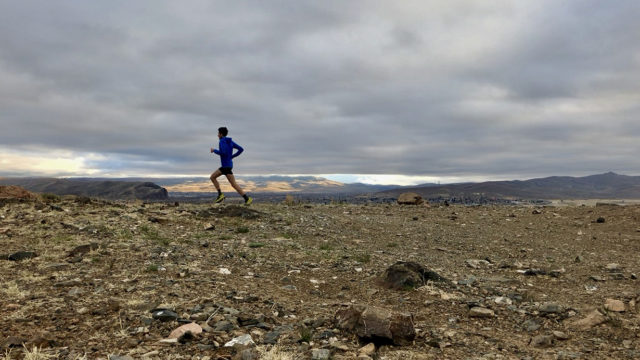
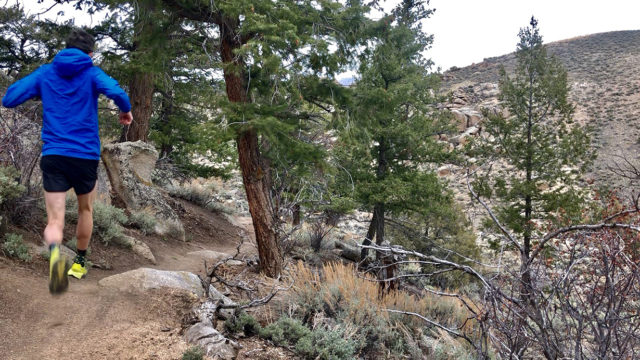
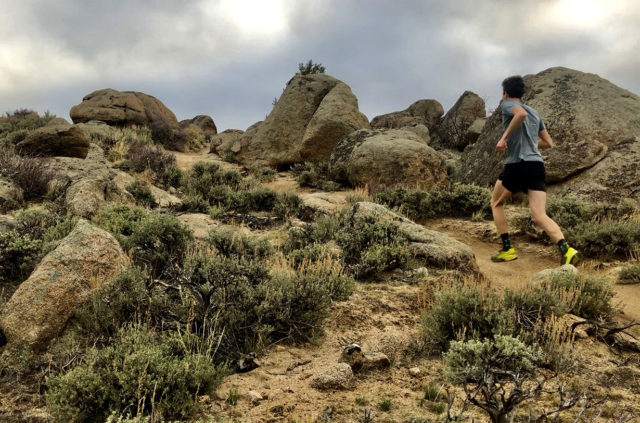
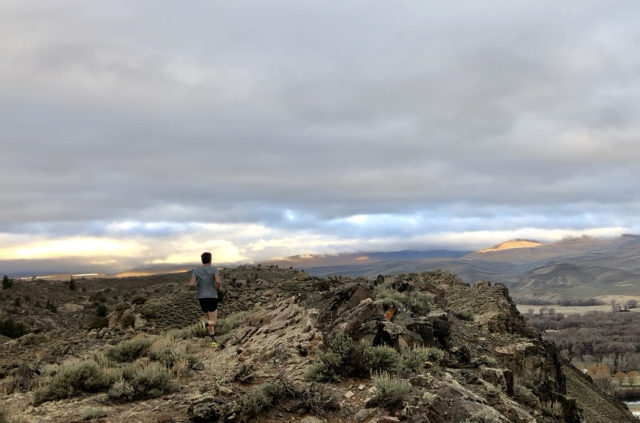
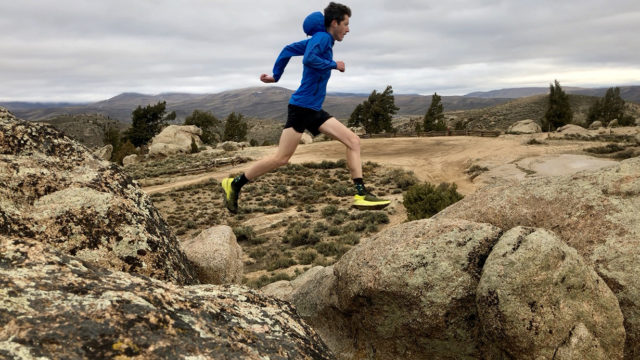
Thanks for the feedback
I also have a narrow heel and low volume foot; as well as wear the sense pro 4s.
My heel tends to move from side to side in my trail runners – tricky finding a good fit. I have read salewa shoes run narrow but was considering the hikes- they just look really big for my foot.
Reading your comments perhaps not.
Cheers for the review
Michelle
Thanks for this great review. Just did a 50 mile Ultra race with 15.500 ft. Elevation in these shows on Saturday, and the shoes was amazing to run in. Definitely my new favorite trail shoe.